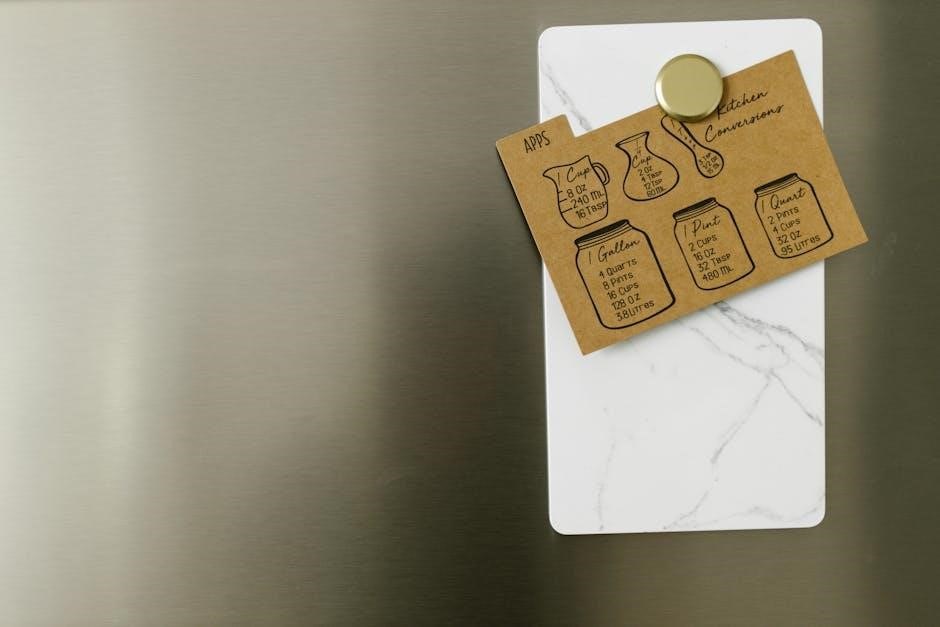Loctite adhesives are renowned for their high performance and versatility in industrial applications. This guide provides comprehensive insights into proper techniques, surface preparation, and curing methods to ensure optimal results.
1.1 Overview of Loctite Products and Their Applications
Loctite offers a diverse range of adhesives and sealants designed for various industrial applications. Their products include instant adhesives for quick bonding, electrically conductive adhesives for electronics, and UV-curable adhesives for precise applications. These solutions cater to industries like automotive, aerospace, and manufacturing, ensuring high performance and reliability. Loctite also provides specialized products like anaerobic gasketing materials and temperature-curable adhesives, which are ideal for demanding environments. Their dispensing systems, such as manual applicators and meter mix dispensers, enhance efficiency in production processes. Whether for general repairs or high-performance assemblies, Loctite products are tailored to meet specific needs, ensuring durability and consistency across applications. This versatility makes Loctite a trusted choice for professionals seeking reliable adhesive solutions.
1.2 Importance of Proper Application Techniques
Proper application techniques are crucial for ensuring the effectiveness and longevity of Loctite adhesives. Incorrect methods can lead to weak bonds, reduced durability, and potential equipment failure. Clean, dry surfaces free from contaminants are essential for optimal adhesion. Using the right dispensing tools, such as manual applicators or meter mix dispensers, ensures precise application. Following recommended curing procedures, like UV light or temperature curing, guarantees the adhesive reaches its full strength. Improper techniques can result in unplanned downtime and increased production costs. By adhering to best practices, users can maximize the performance of Loctite products, enhance reliability, and achieve consistent results across various applications. Proper techniques not only improve efficiency but also help prevent costly repairs and maintenance.

Surface Preparation for Optimal Adhesion
Surface preparation is vital for optimal adhesion. Ensure surfaces are clean, dry, and free from contaminants. Proper cleaning and storage conditions enhance bonding strength and durability.
2.1 Cleaning and Drying Surfaces
Cleaning and drying surfaces are critical steps for optimal adhesion. Surfaces must be free from dust, oil, and contaminants to ensure strong bonding. Use isopropyl alcohol or specialized cleaners to remove grease and grime. Avoid harsh chemicals that may damage the material. Once cleaned, surfaces should be thoroughly dried to prevent moisture interference with adhesion. Proper drying can be achieved with clean, lint-free cloths or air blowers. For best results, ensure surfaces are at room temperature and humidity levels are controlled. Cleanliness and dryness directly impact the performance and longevity of the bond. Always follow recommended cleaning procedures for specific materials to achieve reliable and durable results with Loctite adhesives.
2.2 Removing Dust, Oil, and Contaminants
Removing dust, oil, and contaminants is essential for ensuring strong adhesion. Start by wiping surfaces with a clean, lint-free cloth to eliminate loose particles. For oil and grease, use a solvent like isopropyl alcohol or a specialized degreaser. Apply the solvent to a cloth, not directly to the surface, and wipe in one direction to avoid spreading contaminants. Avoid using harsh chemicals that may leave residues. For stubborn contaminants, repeat the process until the surface is clean. Finally, inspect the surface to ensure no residues remain. Proper removal of contaminants ensures a clean base for adhesive application, enhancing bond strength and reliability. This step is crucial for achieving durable and long-lasting results with Loctite adhesives.

Dispensing Equipment for Loctite Products
Loctite offers a variety of dispensing tools, including manual applicators, meter mix dispensers, and pneumatic systems, designed to ensure precise and efficient adhesive application for different industrial needs.
3.1 Manual Applicators and Their Uses
Manual applicators are versatile tools designed for precise, low- to high-viscosity adhesive dispensing. They are ideal for small-scale or detailed applications, offering handheld convenience and control. These applicators are compatible with various Loctite products, including epoxies and sealants, and are often used for difficult-to-extrude materials. Dual cartridge systems are popular for metered mixing, ensuring proper ratios for optimal bonding. Roller assemblies are another option, perfect for applying anaerobic gasketing products from 300 ml cartridges. Manual applicators are cost-effective and suitable for applications requiring minimal setup, making them a practical choice for workshops and maintenance tasks.
3.2 Meter Mix Dispensers for Precise Application
Meter mix dispensers are designed for precise application of two-component adhesives, ensuring accurate mix ratios for optimal bonding. These systems are ideal for high-viscosity materials and applications requiring consistent results. They are compatible with cartridges of various sizes, such as 300 ml, and often feature adjustable settings to suit different product viscosities. Meter mix dispensers are commonly used in industrial settings where precise control is critical. Their ability to maintain exact mix ratios minimizes waste and ensures reliable curing. These dispensers are versatile, supporting both manual and pneumatic operation, making them suitable for a wide range of applications, from small-scale repairs to large-scale production.
3.3 Pneumatic Applicators for High-Volume Use
Pneumatic applicators are engineered for high-volume industrial applications, offering efficient and consistent dispensing of Loctite adhesives. These systems are designed to handle demanding production environments, ensuring rapid and precise application. They are compatible with a variety of adhesive formulations, including anaerobic gasketing products and high-viscosity sealants. Pneumatic applicators are ideal for large-scale operations where manual methods are impractical. Their robust design and automation capabilities reduce operator fatigue and increase throughput. Many models feature adjustable pressure settings and quick-change cartridges, enhancing flexibility and minimizing downtime. These applicators are essential for industries requiring high-speed, reliable adhesive dispensing, such as automotive, aerospace, and manufacturing sectors.
Curing Methods for Loctite Adhesives
Loctite adhesives utilize UV light and temperature curing for optimal bonding. UV curing offers quick results, while temperature curing follows specific schedules for high-strength adhesion in industrial applications.
4.1 UV Light Curing Process
UV light curing is a popular method for Loctite adhesives, offering fast and efficient bonding. The process involves exposing the adhesive to UV light from specialized systems, ensuring precise control over curing times. This method is ideal for applications requiring rapid assembly and minimal downtime. UV curing promotes strong, durable bonds and is commonly used in industries where high-speed production is critical. Proper alignment and intensity of the UV light source are essential for optimal results. Loctite offers a range of UV curing accessories, such as light guides, to enhance the effectiveness of this process across various industrial applications.
4.2 Temperature Curing Procedures
Temperature curing is a common method for Loctite adhesives, utilizing heat to achieve optimal bond strength. Specific step cure schedules, such as 2 hours at 65°C followed by 3 hours at 125°C, ensure proper curing. A post-cure at 150°C may be required for high-temperature applications. Proper temperature control is critical to avoid overheating, which can degrade the adhesive. This method is ideal for applications requiring high-strength, durable bonds. Controlled environments, such as ovens, are often used to maintain consistent temperatures. Loctite offers products specifically designed for temperature curing, catering to industrial manufacturing needs. Always follow recommended curing parameters to ensure reliable results and longevity of the bond. This process is widely used in automotive and aerospace industries for its effectiveness in high-performance applications.

Types of Loctite Adhesives
Loctite offers a wide range of adhesives, including instant adhesives for quick bonds, electrically conductive adhesives for specialized applications, and high-performance formulations for industrial use.
5.1 Instant Adhesives for Quick Bonds
Loctite instant adhesives are designed for rapid bonding across various materials, ideal for general repairs and high-performance assemblies. They cure quickly, ensuring minimal downtime and strong, durable bonds. These adhesives are versatile, suitable for applications ranging from lightweight plastics to heavy-duty metals. Their fast-setting properties make them a preferred choice in industries requiring swift assembly processes. With formulations tailored to different environments, they provide reliable performance under various conditions. Whether for manufacturing or maintenance, Loctite instant adhesives deliver consistent results, enhancing efficiency and productivity in numerous industrial settings.
5.2 Electrically Conductive Adhesives
Loctite electrically conductive adhesives are specialized for applications requiring efficient electrical conductivity. These adhesives, such as LOCTITE ECI 8090, are designed for low-voltage self-regulating systems and are suitable for manual or pneumatic application. They are ideal for electronics, sensors, and high-reliability packaging. LOCTITE ABLESTIK 8302, for instance, is a die attach adhesive offering excellent conductivity for high-performance semiconductor applications. These products ensure reliable electrical pathways and thermal management, making them essential for modern electronics. With precise formulations, they deliver consistent performance in demanding environments, ensuring durability and efficiency in critical systems;

Cost and Efficiency Considerations
Loctite solutions help reduce production costs and minimize unplanned downtime, ensuring efficient operations and optimal resource utilization for industrial applications.
6.1 Reducing Production Costs
Loctite adhesives and sealants are designed to enhance efficiency, reducing production costs through minimized material waste and optimized application processes. By improving machine reliability and preventing equipment failure, Loctite solutions help lower operational expenses. Proper application techniques and equipment, such as manual and pneumatic dispensers, ensure precise adhesive usage, minimizing excess material. Additionally, Loctite’s high-performance products reduce the need for frequent repairs and downtime, contributing to overall cost savings. These solutions enable manufacturers to streamline production, enhance product quality, and maintain budget efficiency, making Loctite a cost-effective choice for industrial applications.
6.2 Minimizing Unplanned Downtime
Loctite adhesives and sealants are engineered to improve machine reliability, reducing unplanned downtime and enhancing production efficiency. By preventing equipment failure through strong, durable bonds, Loctite solutions minimize unexpected stoppages. Their high-performance formulations ensure consistent and reliable adhesion, reducing the likelihood of repairs and maintenance. Additionally, Loctite’s dispensing systems, such as pneumatic applicators, offer precise control, reducing application errors that could lead to downtime. With Loctite, manufacturers can maintain smooth operations, avoid costly interruptions, and ensure long-term equipment performance. This reliability makes Loctite a key partner in keeping production lines running efficiently and effectively.

Safety Precautions and Best Practices
Always wear PPE, including gloves and goggles, when handling Loctite products. Ensure proper ventilation and follow storage guidelines to maintain safety and product integrity.
7.1 Handling and Storage Guidelines
Proper handling and storage are critical to maintaining the effectiveness of Loctite products. Always store adhesives in their original containers, keeping them away from direct sunlight and moisture. Ensure the storage area is well-ventilated and at a consistent temperature between -25°C to 25°C. Avoid exposing products to extreme temperatures or humidity, as this can alter their properties. Before use, inspect the containers for any signs of damage or tampering. Keep products out of reach of children and unauthorized personnel. For specific storage conditions, refer to the product’s Safety Data Sheet (SDS). Adhering to these guidelines ensures optimal performance and safety when using Loctite adhesives.
7.2 Personal Protective Equipment (PPE)
Wearing appropriate personal protective equipment (PPE) is essential when handling Loctite adhesives to ensure safety and prevent exposure. Always wear chemical-resistant gloves to protect skin from potential irritation. Safety goggles or glasses with a chemical splash guard are recommended to shield eyes from accidental splashes. A respirator or dust mask may be necessary when working in poorly ventilated areas or with products that emit vapors. Ensure all PPE meets local safety regulations and is compatible with the adhesive being used. Additionally, wear protective clothing such as lab coats or coveralls to prevent skin contact. Regularly inspect PPE for damage and replace as needed. Proper use of PPE minimizes risks and ensures a safe working environment when applying Loctite products.

Troubleshooting Common Issues
Identify adhesion problems by checking surface cleanliness and proper curing times. Address dispenser malfunctions by recalibrating or replacing worn parts to ensure consistent application and minimize downtime.
8.1 Identifying and Solving Adhesion Problems
Adhesion issues often arise from improper surface preparation. Ensure surfaces are clean, dry, and free of contaminants. Verify curing times and temperatures align with product specifications. If adhesion fails, check for insufficient UV light intensity or incorrect mixing ratios; Contaminants like oil or dust can weaken bonds; use solvents to clean surfaces thoroughly. For anaerobic adhesives, ensure mating surfaces are tightly fitted. If issues persist, consult Loctite technical support for tailored solutions. Proper handling and storage of adhesives are also crucial to maintain their effectiveness. Always follow the recommended application procedures to achieve reliable and durable bonds in your projects. This ensures optimal performance and minimizes the risk of adhesion-related failures. Regularly inspect equipment and materials to prevent potential problems before they occur.
Dispensing equipment malfunctions can disrupt production. Identify issues like clogged nozzles or inaccurate mix ratios. Clean nozzles with solvents and ensure proper alignment. Check for worn seals or faulty valves. Regular maintenance, like replacing O-rings, prevents downtime. For pneumatic applicators, inspect air pressure settings and filters. Ensure all parts are compatible with Loctite products. Troubleshoot by reviewing manufacturer guidelines or contacting support. Keep spare parts on hand to quickly resolve issues. Proper care extends equipment lifespan and ensures precise application. Addressing malfunctions promptly minimizes production delays and maintains product quality. Always follow safety protocols when servicing equipment. Regular training for operators can prevent errors and enhance efficiency. Consistent upkeep ensures reliable performance and reduces operational costs over time.
Loctite promotes eco-friendly solutions, offering adhesives with reduced volatile organic compounds. Proper disposal of unused products prevents environmental contamination, aligning with sustainability goals and regulations. Loctite offers a range of eco-friendly adhesives designed to minimize environmental impact. These products feature reduced volatile organic compounds (VOCs) and non-toxic formulations, making them safer for the environment. Many Loctite adhesives are biodegradable and free from hazardous chemicals, aligning with global sustainability standards. The company also provides adhesives with low-energy curing processes, such as UV light curing, which reduces carbon emissions. Additionally, Loctite’s instant adhesives and electrically conductive adhesives are formulated to be more efficient, reducing waste and over-application. These eco-conscious solutions help industries meet environmental regulations while maintaining high performance. By choosing Loctite’s green products, users can contribute to a more sustainable future without compromising on quality or reliability. Proper disposal of unused Loctite products is essential for environmental protection and compliance with regulations. Always follow local, state, and federal guidelines for hazardous waste disposal. Unused adhesives should be stored in their original containers with tightly sealed lids to prevent contamination. Empty containers can be safely disposed of in regular trash if completely dry. For partially filled containers, contact a licensed hazardous waste disposal facility. Never pour adhesives down drains or sewers, as they can harm aquatic life. Additionally, Loctite offers eco-friendly options and recycling programs for certain products. Proper disposal ensures minimal environmental impact and aligns with sustainable practices. Always refer to the product’s Safety Data Sheet (SDS) for specific disposal instructions.8.2 Addressing Dispensing Equipment Malfunctions

Environmental Impact and Sustainability
9.1 Eco-Friendly Loctite Product Options
9.2 Proper Disposal of Unused Products